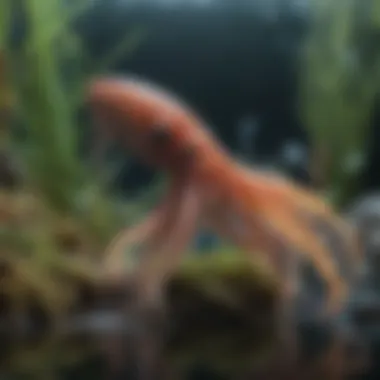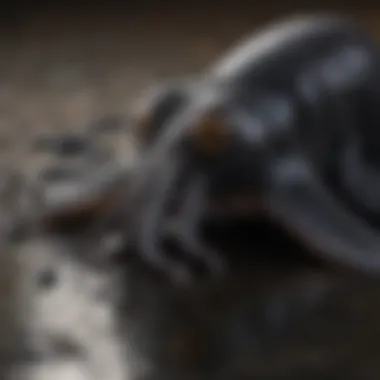Exploring the Role of Squid Ink in Nature and Culture


Intro
As we journey into the world of squid ink, we uncover a substance that is far more than a simple escape mechanism for cephalopods. This intriguing secretion, rich in history and potential, offers insights into not only biological adaptations but also human uses that stretch across time and industry. Squid ink serves vital ecological roles, affecting everything from predator-prey dynamics to potential applications in healthcare.
In this comprehensive study, we will unravel the layered importance of squid ink, exploring its biological origins and chemical make-up. We will dive into how these natural marvels communicate and thrive within their underwater realms, and how they are adapting to the pressures of a changing environment. This exploration will also highlight past and present uses of squid ink in various fields, emphasizing the intersection of nature and human creativity.
We invite you to explore this fascinating liquid that has navigated the depths of both ocean ecosystems and societal uses — representing a complex narrative that connects cephalopods to artistry, science, and environmental discussions. By understanding the multifaceted roles of squid ink, we not only broaden our ecological knowledge but also deepen our appreciation for the intricate tapestries that make up our natural world.
Prelude to Squid Ink
The study of squid ink holds a unique place in both biological science and cultural history. As we delve into this topic, it becomes clear that squid ink is not just a mere byproduct; it's a fascinating substance packed with complexity and significance. One major aspect to recognize is its role in the survival strategies of cephalopods, highlighting how nature crafts tools that aid in evasion from predators. Additionally, its applications in diverse fields, ranging from art to medicine, illustrate its versatility and multifaceted character.
To fully appreciate squid ink, one must first grasp its definition. Understanding what it consist of helps to illuminate its uses. Beyond the biology, history provides a rich tapestry where squid ink has woven itself into various cultures, showing how humans have interacted with it over the centuries.
Definition and Overview
Squid ink, primarily expelled from the ink sac of squids and other cephalopods, is a dark, viscous fluid. This substance serves vital functions in the animal's life, particularly in defense mechanisms against predators. Chemically, it comprises several elements, primarily melanin, which lends the ink its distinct coloration. The ink also contains proteins, lipids, and various chemical compounds that could further support its roles.
The ink acts like a smoke screen when released into the water, allowing the squid to make a hasty escape from looming threats. Moreover, it's worthy to note that the ink is not homogenous; its composition can change depending on the species and environmental factors, which in turn affects its efficacy as a defensive tool.
Historical Context
Historically, the significance of squid ink stretches far beyond its biological functions. In ancient civilizations, it found its way into art, literature, and cuisine. The ink was a common medium for writing and drawing, with its rich pigment prized for creating striking visuals that stood the test of time. Famous writers from the classical periods often used inks derived from squid or other cephalopod sources to pen their thoughts, leaving behind a cultural legacy that resonates even today.
Additionally, culinary practices in Mediterranean countries often incorporate squid ink, creating signature dishes like risotto al nero di seppia—a classic delicacy in Italy that showcases the rich flavor profile of the ink. Here, the historical and the culinary aspects intertwine, showing how squid ink has not only survived through time but also thrived in various contexts.
As we continue to unfold the layers surrounding squid ink, its ecological, chemical, and cultural significance become more apparent, building a holistic understanding of this remarkable substance.
Biological Functions of Ink
Understanding the biological functions of squid ink is key to grasping its significance in the animal kingdom and beyond. Squid ink is not merely a byproduct of these fascinating creatures; it serves multiple crucial roles that enhance survival and effective communication. In this section, we will dive into the remarkable functions of squid ink, focusing on its defense mechanisms and communication capabilities, exploring the nuances and implications of each aspect.
Defense Mechanisms
The primary role of squid ink lies in its defensive capabilities against predators. This section breaks down the intricacies of prideful predator evasion and the artful distraction strategies squid employ during dire situations.
Predator Evasion
Predator evasion embodies a pivotal trait of squid ink, characterized by its sudden release that creates a visual smokescreen in the water. This momentary cloud not only obscures the squid's original location but also confuses its attackers, buying the cephalopod precious time to escape. This approach is particularly effective when it comes to fast-moving predators like certain fish.
The key characteristic of predator evasion using ink is the sheer unpredictability of the squid's agile movement paired with the ink’s ability to dissipate quickly. It turns the situation from a chase into a cat-and-mouse game, where the squid has the upper hand. It’s a fascinating interplay of strategy and biology, showcasing how adaptation leads to survival.
However, there’s a caveat. While the ink cloud is advantageous, it can also create visible markers in the water, making the squid potentially detectable by keen-eyed hunters if the squid doesn't act swiftly. Recognizing these advantages and disadvantages provides a clearer picture of the evolutionary tactics in play.
Distraction Strategies
Distraction strategies take this concept one step further. Beyond just providing concealment, squid often release ink in a manner that obfuscates their movements. For example, by adding chemical cues to the ink, squids not only mask their presence but can also trigger the prey of their predators to flee in confusion, adding an extra layer of deception.


This unique feature of distraction through ink clouds is another beneficial aspect highlighted in this article. The ink’s production isn’t merely a default response but an intelligent tactic. It’s like throwing sand in someone’s eyes during a scuffle - it makes it hard for the opponent to focus. Yet again, while an effective means of escape, this method does require skill and timing from the squid. One miscalculation, and the squid risks becoming a meal rather than evading a predator.
Communication
The role of squid ink extends into the realm of communication. This fluid not only serves defensive purposes but may also play a role in signaling among squids and other marine life. The ink can carry chemical signals that convey information about distress, territorial boundaries, or even mating readiness. These nuances serve as an underlying layer to the understanding of squid interactions in their complex aquatic world.
In summary, the biological functions of squid ink are not just fascinating; they are essential for survival and interaction in the vast oceans. From evading predators to intricate forms of communication, studying these elements not only highlights the ingenuity of cephalopods but also allows for a richer understanding of their ecological roles and contributions.
Chemical Composition of Squid Ink
Understanding the chemical composition of squid ink is essential for grasping its role not just in the life of squid but also in various scientific and artistic fields. This ink isn’t merely a defensive secretion; it’s a complex concoction containing components that have significant implications across disciplines. The ink's chemical structure is a treasure trove of secrets, ranging from protective functions to potential applications in medicine and art.
Major Components
Melanin
One of the paramount players in the game of squid ink is melanin. Known primarily for giving color to skin and hair in many animals, in squid ink, it serves additional purposes as well. This pigment not only provides that dark hue but also contributes to the ink's ability to obscure visibility, making it harder for predators to pinpoint the squid during an escape. Its primary characteristic, aside from its color, is its stability; melanin is resistant to degradation, which is a significant advantage when considering ink's efficacy in the turbulent marine environment.
In this context, melanin can be viewed as a beneficial choice because it offers both coloration and protection. However, one has to wonder about its drawbacks too. While it effectively hides the squid, once the ink disperses, the melanin can create a cloudy veil that might obstruct the squid's own vision as well.
Chemical Cues
Now, stepping into the realm of chemical cues, we find yet another fascinating element of squid ink. These are specialized molecules released along with the ink that heighten communication among cephalopods and other marine life. Chemical cues play a significant role in signaling danger or even attracting mates, with specific characteristics tailored for interaction.
A key feature of these chemical cues is their ability to stir swift responses in other animals. Their deployment in squid ink highlights a dynamic adaptation for survival and social interaction. These cues are a beneficial inclusion; they help create a multi-layered defense strategy. But, similar to melanin, their downside is that they can be diluted in the water, lessening their efficiency. The balance between visibility and camouflage is delicate.
Variability by Species
Species-Specific Differences
Diving deeper into the chemical make-up, it's evident that there are species-specific differences in squid ink composition. Not all squid produce the same ink. For instance, different species, like the common cuttlefish and the giant Pacific octopus, have distinctive chemical signatures in their inks. The variance in these compounds is crucial, as each species has adapted to its unique ecological niche.
The adaptability and diversity among species suggest that understanding these differences can improve our knowledge of marine ecosystems and even influence conservation efforts. The unique feature here is how species differentiate themselves chemically, which may provide insights into evolutionary biology. This can also benefit marine museums and educational publications that aim to educate about biodiversity in cephalopods. However, the complexity of these variations poses challenges in standardizing scientific research and application.
Adaptations
Finally, there are the adaptations that various squid species have developed over time due to environmental factors. These adaptations are not just about the ink’s basic function; they reflect the responses to predators, conspecific interactions, and the ecological challenges they face. For example, some squids might produce ink with enhanced properties for immediate dispersal in turbulent waters, allowing for a quick escape.
This characteristic of adaptability offers a remarkable insight into how organisms can fine-tune their defenses. The benefits of these adaptations highlight the ingenuity of marine life. Yet, such variability could complicate efforts to utilize squid ink in other fields, such as pharmaceuticals or food industry practices, since what works for one species may not be suitable for another. Additionally, extraction protocols may need adjustments, underscoring the importance of tailoring approaches to specific species.
Understanding the chemical composition and variability of squid ink is not just oceanic trivia; it provides useful insights into ecological dynamics and potential applications in medicine and art.
Cultural Significance of Ink
The cultural impact of squid ink extends far beyond its biological characteristics. It showcases human ingenuity, creativity, and a connection to nature that transcends generations. This section aims to articulate how squid ink finds its place within both the artistic and culinary landscapes, demonstrating its relevance as a historical and contemporary medium.
Applications in Art


Historical Use in Literature
Historically, squid ink has been recognized for its unique qualities, notably its deep, rich color that has made it a preferred choice for writers over centuries. This distinctive hue not only adds a certain gravitas to writings but also ties the art of writing back to nature, playing a crucial role in the narratives of various cultures. The key characteristic of squid ink in literature is its ability to blend seamlessly with paper, creating a texture that resonates with readers on an aesthetic level.
Its usage can often be traced back to the ancient scribes, who understood the importance of using durable materials, leading to squid ink’s popularity over other inks that faded easily. This choice has proven beneficial, as many historical texts have survived millennia, partly due to the longevity of squid ink. One unique feature of this ink is that it’s produced in such a way that it can carry elaborate details, making it ideal for artistic calligraphy. However, it is worth noting that the production of squid ink, particularly in earlier times, depended solely on natural resources, emphasizing an environmental cost that modern artists must now consider.
Modern Artistic Expressions
In more recent times, squid ink has resurged as a trendy medium of expression in mixed media art. Contemporary artists are drawn to its deep black tone and fluidity, using it to infuse their work with a touch of nature. The beauty of squid ink lies in its versatility, as it easily integrates with other mediums, adding dimension and depth.
Many artists today highlight its ecological origin, utilizing it as a statement about sustainable practices in art. This trend has not only revitalized interest in traditional squid ink but also prompted discussions regarding the balance between artistic freedom and environmental responsibility. One rather interesting advantage of using squid ink is that it imparts a shine that enhances artworks when viewed in certain lights. In contrast, some purists argue that its use detracts from the integrity of traditional materials, sparking a debate among artists about authenticity in modern art.
Culinary Uses
Gastronomic Traditions
In gastronomy, squid ink is a cherished ingredient found primarily in Mediterranean cuisine, particularly in dishes like paella and black risotto. This not only highlights its culinary versatility but also represents a deep cultural connection to the ocean, connecting people to their historical roots. The key characteristic of using squid ink in food is its ability to provide a striking visual presentation, transforming simple dishes into exquisite culinary experiences. From the perspective of chefs, the benefit of incorporating squid ink lies not only in its striking appearance but also in its health benefits, as it is rich in antioxidants, adding value to its culinary role.
Flavor Profile
The flavor profile of squid ink is unique and complex, often described as briny with a hint of the ocean’s essence. This characteristic makes it a beneficial choice for chefs looking to elevate dishes with a subtle umami flavor that complements seafood wonderfully. Its ability to enhance the taste of other ingredients decisions in cooking is an advantage that has gained popularity in culinary schools and gourmet restaurants alike.
While its appeal is broad, the unique feature of squid ink lies in how it interacts differently with various base ingredients. On the downside, some may find its flavor too intense for certain palettes, leading to mixed reviews. Regardless, its culinary significance is undeniable, sitting at the intersection of tradition and innovation in our modern dining experiences.
"Ink, whether on paper or in dishes, tells a story that connects us to our past and informs our present."
Through exploring these cultural roles, we see how squid ink is not simply a byproduct of cephalopods but a bridge between nature and human creativity, serving as a testament to our ongoing relationship with the environment.
Scientific Research on Squid Ink
The research surrounding squid ink stretches the boundaries of conventional science, revealing a mix of biological intrigue and potential benefits. Much more than just a defensive secretion, this ink showcases diverse applications that could usher in advancements across multiple fields including medicine, environmental science, and sustainable practices. By diving into the therapeutic potential of squid ink, the environmental ramifications of its use, and ongoing studies, we can discern its role not only in nature but also in human innovation.
Therapeutic Potential
Antimicrobial Properties
When we talk about antimicrobial properties, we're discussing how squid ink shows promise in combating various bacteria and even some viruses. Researchers have found that certain compounds in squid ink can inhibit the growth of harmful pathogens. This key trait makes it intriguing for potential medical applications.
A noteworthy aspect is the presence of natural antimicrobial substances which can provide a more holistic approach to fighting infections. In an age where antibiotic resistance is growing, squids' Ink could offer an alternative. It's particularly relevant because it aligns with a larger movement towards seeking natural solutions rather than synthetic antibiotics.
However, the unique feature of these properties also raises questions. While animal-based inks could be promising, ethical concerns about sourcing and sustainability should be considered seriously. Striking a balance between innovation and ecological awareness is crucial.
Pharmaceutical Applications
Turning our gaze toward pharmaceutical applications, squid ink is being examined for its potential roles in drug development. Certain components of the ink have shown capabilities that might translate to effective drug formulations, particularly in creating new treatments for diseases.
The standout characteristic here is the bioactive compounds present in the ink that can target specific health issues. This isn’t just pie-in-the-sky research; studies and trials are being conducted to comprehend if these compounds can be harnessed more broadly. One potentially powerful aspect is how these compounds might interact with existing medications, although more research is needed to understand any possible interactions fully.


Similarly to the antimicrobial properties, the unique feature of these pharmaceutical potentials warrants cautious optimism. What might initially appear as a simple ink holds multifaceted implications for health care in the future. Nonetheless, we need to weigh out both benefits and challenges to reduce any adverse effects.
Environmental Impact Studies
The environmental ramifications of squid ink research cannot be overlooked. Understanding the ecological balance surrounding squid populations and their habitats is essential, especially as harvesting practices evolve. Research indicates that overfishing poses a significant threat not only to the squid populations but also to marine ecosystems as a whole.
The link between squid ink and the ecosystem is richly intertwined. If harvesting squid for their ink becomes a commercial venture, it could lead to pressures on their populations.
Moreover, studies on the long-term impact of squid ink usage on the marine environment are ongoing. Researchers are emphasizing the importance of sustainable practices to ensure that these cephalopods can thrive in their oceanic homes. Here, dialogue among scientists, conservationists, and policymakers becomes pivotal to navigate the potential benefits against ecological impact.
To wrap it all up, the scientific exploration of squid ink opens avenues for therapeutic solutions, pharmaceuticals, and a chance to dive deeper into our understanding of marine environments. As we push forward, it's vital to keep in mind the interconnectedness of these threads, fostering an ecosystem of knowledge that benefits not only human health but the health of our planet.
Conservation and Sustainability
In the discourse surrounding squid ink, the themes of conservation and sustainability hold much weight. With the growing interest in marine ecosystems and the role of cephalopods, understanding how squid ink relates to ecological health is essential. The sustainable management of squid populations not only preserves the species but also maintains the balance of marine environments where they thrive. This section will explore the critical elements surrounding conservation efforts, examining the benefits of sound practices and the challenges stemming from overfishing.
Impact of Overfishing
Overfishing poses a significant threat not only to squid populations but also to the broader marine ecosystem. As demand for squid ink rises in culinary and artistic realms, unsustainable harvesting can lead to serious decline in squid numbers. This can result in a ripple effect on the food chain, affecting species that prey on squid and those that are in turn preyed upon by them.
- Decreased Biodiversity: Heavy fishing pressure can lead to a loss of genetic variation in squid populations, making them less resilient to diseases and environmental changes.
- Altered Ecosystems: When squid populations diminish, there could be an imbalance in predator-prey relationships, leading to overpopulation of their prey species and subsequent degradation of sea grasses and other vital habitats.
The international community is becoming increasingly aware of these impacts. To address this, various management regulations and measures have started to emerge, aimed at protecting squid stocks.
Sustainable Harvesting Practices
Fortunately, sustainable harvesting practices have shown to be effective in maintaining squid populations while allowing for their ink to be harvested responsibly. These methods not only focus on the current state of squid populations but also consider the long-term health of marine ecosystems. Here are some key practices in sustainable harvesting:
- Controlled Quotas: Setting limits on the quantity of squid that can be harvested each season helps to ensure populations are allowed to regenerate.
- Selective Fishing Gear: Utilizing gear that specifically targets mature squid can prevent juveniles from being caught, thereby allowing them to grow and reproduce.
- Monitoring and Research: Continuous scientific research and monitoring provide necessary data that can inform policymakers, guiding adjustments to quotas and fishing methods based on population assessments.
“Sustainable management doesn't just keep squid in the sea; it ensures that future generations can enjoy the unique benefits of squid ink and the vibrant ecosystems where these creatures thrive.”
Ultimately, focusing on conservation and sustainable practices requires collective efforts from governments, fishing industries, and consumers alike. By advocating for sustainable squid ink sourcing, we can enjoy the myriad benefits of this ancient resource without compromising the health of our oceans. The responsibility lies not just on one group, but on all who appreciate the deep, rich history and utility of squid ink in art, cuisine, and science.
Finale
The examination of squid ink within this article underscores not only its biological and chemical significance, but also its broader implications in the realms of culture and sustainability. As we seek to comprehend the multifaceted roles of squid ink, we uncover a narrative that extends well beyond mere survival strategies in the aquatic world. It's a unique blend of artistry and science, serving as a bridge between natural ecosystems and human innovation.
Summary of Findings
Throughout the exploration of squid ink, several key points have emerged:
- Biological Functions: Squid ink plays a crucial role in the defense mechanisms of these cephalopods, primarily through predator evasion and distraction strategies, making it an essential tool for survival.
- Chemical Composition: The ink's rich chemical makeup, including melanin and various chemical cues, not only serves defensive purposes but also holds potential in various therapeutic applications.
- Cultural Significance: Squid ink has found a prominent place in the arts and culinary traditions, suggesting an enduring interest in its utility and symbolism across cultures.
- Scientific Research: Recent studies have highlighted the antimicrobial properties of squid ink, paving avenues for pharmaceutical exploration, revealing a promising frontier in medicine.
- Conservation Concerns: The impact of overfishing on squid populations raises important questions about sustainability, emphasizing the need for responsible harvesting practices to preserve both the species and the ecological balance.
These findings illustrate the ink's integral role—spanning biology, culture, and environmental sustainability—making squid ink a subject worthy of continued inquiry.
Future Research Directions
Looking ahead, further investigation into squid ink could encompass various exciting avenues:
- Biodiversity Studies: Research could focus on understanding how different species of squids produce ink and the implications of their varied chemical compositions in adapting to different ecological niches.
- Technological Applications: There’s scope for innovation in materials science, where the distinctive properties of squid ink could inspire new biodegradable materials or novel uses in textiles.
- Cross-Disciplinary Approaches: Engaging with artists, chefs, and biologists could promote interdisciplinary collaborations that enhance our comprehension of squid ink’s diverse applications and cultural contexts.
- Sustainability Initiatives: Future studies should aim to establish sustainable practices for harvesting squid ink, ensuring that cephalopod populations remain healthy and that ecosystems thrive.
In essence, squid ink is not just a fascinating subject of study; it is a reminder of how interconnected life and culture can be, urging us to approach the natural world with curiosity and respect.







